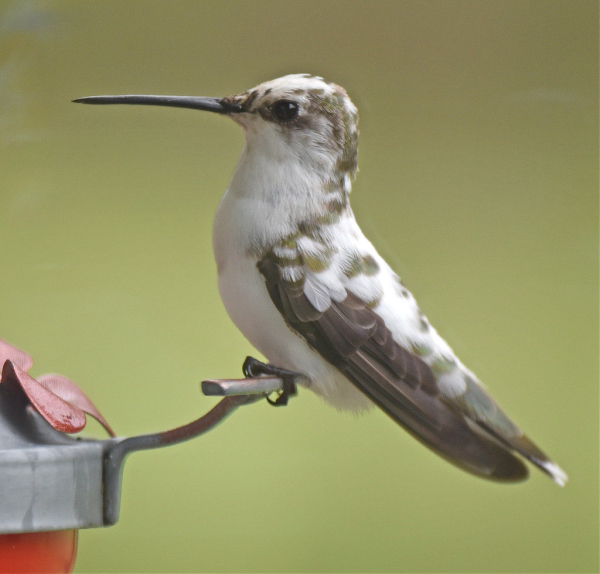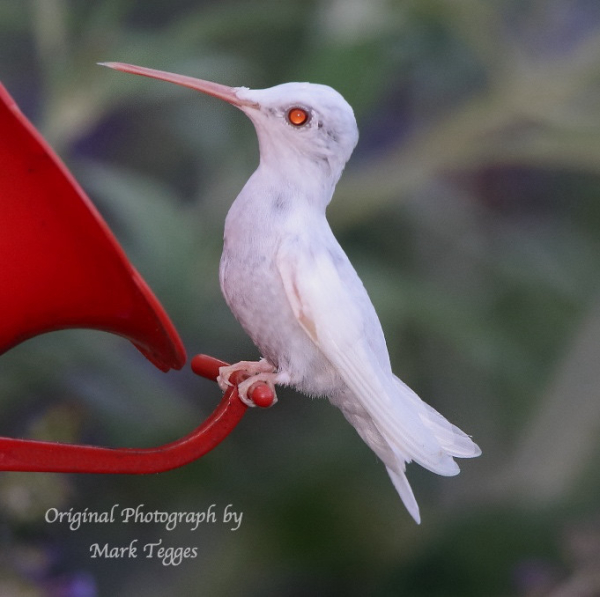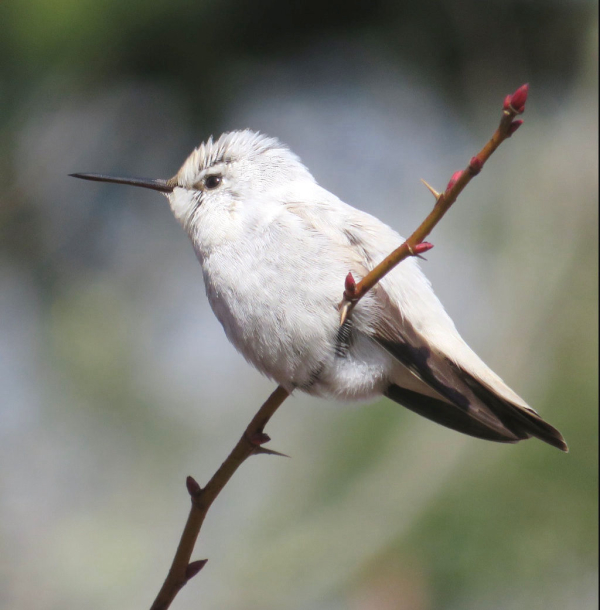
A partial albino or leucistic hummingbird, photographed last month in Oklahoma by J. Jones.

An albino Ruby-throated Hummingbird photographed in Maryland in May 2019 by Mark Tegges.

A leucistic Anna’s Hummingbird that resembles an albino was photographed in southwest British Columbia last February by A. Miller.
|
Albino birds always attract a lot of attention – they are very rare in nature, and they are often quite delicate; they may have impaired vision in their pink eyes, and they are not very likely to survive very long. People get even more excited about albino hummingbirds, along with partial albinos that show some white plumage mixed with normal-colored feathers. These “white” hummingbirds are super rare, but you would probably be surprised to find out just how many albino and partial-albino hummingbirds visit backyard feeders.
Luckily, “Hummingbird Central” has been doing a remarkable job of keeping track of and listing albino and partial-albino hummingbirds found across the continent. Already this year they recorded 5 “white” hummingbirds, along with 35 during 2020, and a few more during 2019.
True albinos have all white plumage with pink eyes and lighter-colored body bare parts, such as their feet, legs, and bill. Partial albinos can be very impressive looking, depending on where the white feathers appear among the normally colored plumage – all are truly distinct and quite unique. Partial albinos, also known as leucistic hummingbirds, have normally colored eyes, bill, and feet.
We share a few photos of leucistic and albino hummingbirds with you, and hope you keep alert for any “ghost hummers” that might visit a feeder near you. For more information about albino and leucistic hummingbirds, refer to Hummingbird Central at https://www.hummingbirdcentral.com/white-albino-hummingbirds.htm
Attracting Hummingbirds (White & All Others)
After spending the fall and winter months in Mexico or Central America, a variety of hummingbird species are migrating north, or have completed their migrations to nesting sites to establish a territory, pair, nest, and raise young. Eight primary species migrate north of the Mexican border, including Ruby-throated, Rufous, Broad-tailed, Black-chinned, Calliope, Costas, and migratory populations of Anna’s and Allen’s Hummingbirds.
We may be able to attract new birds to stop and stay a while – to nest in your yard or neighborhood, after finding out there is a predictable source of sugar-water nectar, and fresh water on the edge of backyard habitats. Here’s how:
– Provide sugar-water in the form of nectar in a hummingbird feeder. Remember, hummingbirds are especially attracted to the color red.
– Provide a flower garden or potted flowering plants, especially native plants with red flowers. They can add another dimension to providing nectar – real flower nectar.
– Provide fresh water; and if you add the sound of moving water via a sprayer or dripper, more birds are sure to find your watering and feeding station.
It’s all pretty simple, and if hummingbirds have already passed through your area, it’s never too early to prepare for their return during their late summer migration south. Then, during mid- to late summer, hummingbirds tend to spend more time at our hummingbird feeders and flower gardens, giving us a better, longer opportunity to appreciate them – and to watch for any hummers with white feathers. Best wishes throughout this “hummingbirding season!”
Share your backyard birding experiences and photos at editorstbw2@gmail.com